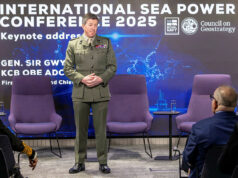As part of NATO’s latest historic ordnance disposal operations, Standing NATO Mine Countermeasures Group One (SNMCMG1) has mapped 35 underwater mines and 3 aircraft bombs in the seabed of Norway’s Oslofjord.
“Sea mines are legal weapons, and we know that many navies have large amounts of them in stock. So it is highly likely that these will be used in crisis or war. They will hamper our way of living, stopping all logistics coming with merchant shipping. It will also hamper a nation’s ability to receive Allied reinforcements, if needed. No merchant or military unit except for the mine countermeasure vessels will enter an area with a mine threat,” said Commander of SNMCMG1 Henning Knudsen-Hauge in a news release.
Around 1,800 mines remain in the Oslofjord from World War II, endangering fishing and shipping in the area if they are not mapped and identified.
“The operations were conducted with support from the Royal Norwegian Mine Warfare Datacentre, who embarked aboard the German flagship FGS Donau during the operations. During the recent years the RNoN Mine Warfare Datacentre have studied historical publications and logbooks, and have traced the actual amounts of mines used, and the precise position where they were dropped in the Oslofjord.
SNMCMG1 is one of four standing forces that comprise the maritime component of the Very High Readiness Joint Task Force (VJTF), which is part of the NATO Response Force (NRF). To respond to contingency situations additional forces can be added to these groups, with the NATO command staff onboard and the ships of the group as the nucleus, capable of providing timely support to NATO operations.”
SNMCMG1 is currently comprised of five assets: HNoMS OTRA (Norway), HNLMS Willemstad (Netherlands), BNS Bellis (Belgium), HMS Grimsby (United Kingdom) and flagship FGS Donau (Germany).














Should the UK have small tankers like the Italian Navys ones at a couple thousand tonne, for inshore and operations like this? Far cheaper than sending a 39,000 tide. Keep the tides for global operations and smaller tankers for everything else.
The old Rover class would have been good or possibly even the Fort Rosalie if she had fuel bunkers. I would prefer the Fort Rosalie with a fuel capability, hard stores, munitions and four helicopters. A good general purpose supply ship.
As a general question I wonder what the mine hunters would do if they found a Tall Boy or Grand Slam.
No. Small tankers need as many crew and have far less utility. They’re also only marginally cheaper cost wise.
There could be an argument for a couple of more general AOR class ships to replace the Wave’s eventually. Like the Tide derivative HNoMS Maud. For single ship or smaller deployments. But she’s still a big vessel. The UK has also soured on the idea of AOR’s, as has the USN. All store ships recently are single purpose (although most tankers have the ability to store up to 20 containers on deck for solid stores).
Bay clas LSDs have been used to support this type of operation in the past. They can carry sufficient fuel and materials to supply and maintain a number of smaller vessels. I think most readers of this site can agree that the Bays have been fantastic value for money and incredibly flexible in their tasking.
‘No merchant or military unit except for the mine countermeasure vessels will enter an area with a mine threat,” said Commander of SNMCMG1 Henning Knudsen-Hauge.’
During the Falklands war, prior to the landings at San Carlos, the commander of the assault needed to know if the waters between East and West Falkland had been mined. Lacking any mine hunters, they sent a Type 21 frigate through to check. Puts things into perspective when anyone mentions expendable.